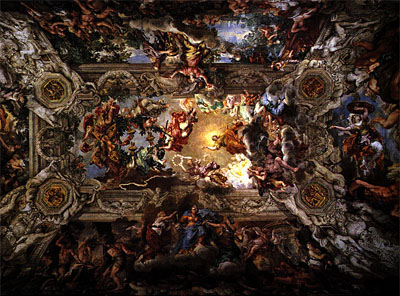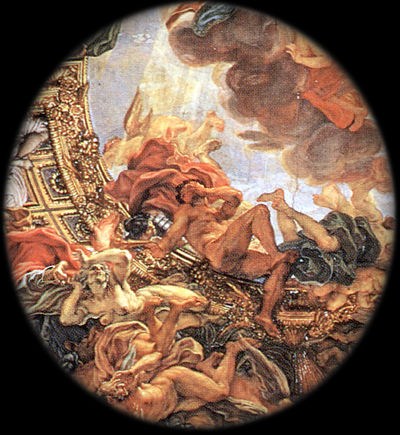|
The problem of the frame is not new. A particular period that is directly relevant to this discussion is the early Baroque. In the seventeenth century, the Baroque fresco artists attempted solutions to the problem of the frame. Their works experimented with the boundary between image, frame, and the geometric structure that supported it. Such works were constructed so that "the ensemble made a theatrical and emotional assault on the spectator, enmeshing them in a spatial geometry whose lines are never still, leading them from one enclave to the next, involving him in the drama depicted in the picture, confusing the spatial domains of art and reality." [2] Interestingly, to
term a work “Baroque” was originally meant as a derogatory
slur. Despite slow acceptance, the artists responsible seemed most sure
of the validity of their work. Indeed, production of such works required
great technical skills combined with dedication and perseverance (major
works took many years to complete). Such works of art reached out in
every direction physically and emotionally, trying to escape beyond
the frame, to draw the viewer into its orbit. Whereas Renaissance painters
and patrons had been fascinated by the visual possibilities of perspective
and of the fact that the viewer could look into a spatial illusion,
seventeenth and eighteenth century artists regarded viewers as participants
in the work of art and architecture. |
|
 |
Pietro da Cortona: Triumph of the Barberini, Palazzo Barberini, Rome 1633-39 |
Gaulli, considered by many as the master of the genre, produced the ultimate illusionist Baroque ceiling in Triumph of the Name of Jesus (detail below). This astonishing creation went beyond anything that had preceded it in “unifying architecture, sculpture, and painting. Every element is dedicated to the illusion that clouds and angels have floated down through an opening in the church's vault into the upper reaches of the nave.” [2] |
|
 |
|
|
Giovanni
Battista Gaulli. Triumph of the Name of Jesus (detail), Church
of Il Gesù, Rome 1676-79
|
|
